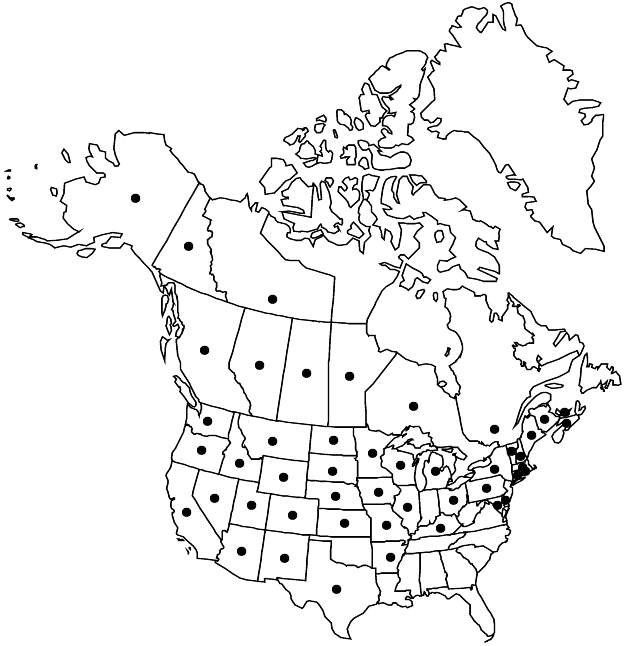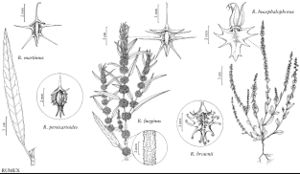Difference between revisions of "Rumex fueginus"
Anales Univ. Chile 91: 493. 1895.
FNA>Volume Importer |
FNA>Volume Importer |
Revision as of 22:32, 16 December 2019
Plants annual, rarely biennial, usually distinctly papillose-pubescent mostly in inflorescence and on leaf blades abaxially, or occasionally at most weakly papillose-pubsecent, with fusiform, vertical rootstock. Stems erect (some dwarf alluvial forms may be with ascending or almost prostrate branches), branched in distal 2/3, occasionally almost near base, (4–)15–60(–70) cm. Leaves: ocrea mostly partially persistent at maturity; blade lanceolate or lanceolate-linear, rarely oblong-lanceolate, (3–)5–25(–30) × (1–)1.5–3(–4) cm, more than 4 times as long as wide, base abruptly truncate, slightly cordate, or rarely broadly cuneate, margins entire or subentire to obscurely repand, normally undulate and crisped, apex acute very rarely subobtuse. Inflorescences terminal, occupying distal 1/2 of stem (occasionally most of stem), usually reddish brown or red (greenish yellow when mature), usually rather dense, interrupted in proximal part, broadly paniculate. Pedicels articulated near base or at least in proximal 1/3, filiform, 3–7(–9) mm, articulation weakly evident, occasionally indistinctly swollen. Flowers 15–30 (occasionally more) in rather dense whorls; inner tepals narrowly triangular or narrowly rhombic-triangular, 1.5–2.5 × 0.7–0.9(–1.2) mm (excluding teeth), normally ca. 2 times as long as wide, base truncate or broadly cuneate, margins usually prominently dentate, rarely with shorter teeth, or almost entire, apex acute, straight, teeth 2–3, at each side of margins, subulate-filiform, bristlelike, straight, 1–3 mm, usually 1.5–2.5(–4) times as long as width of inner tepals; tubercles 3, brownish or reddish, linear-lanceolate to fusiform, equal or subequal, rarely unequal, distinctly narrower than inner tepals, ca. 0.5 times as wide as inner tepals or less, apex acute or subacute, usually distinctly reticulate-pitted (especially in herbarium specimens). Achenes light brown, 1.1–1.4 × 0.6–0.8 mm. 2n = 40.
Phenology: Flowering late spring–early fall.
Habitat: Alluvial, riparian, and ruderal habitats, shores, marshes, bogs, wet meadows, dry streambeds
Elevation: 0-2500 m
Distribution

Alta., B.C., Man., N.B., N.W.T., N.S., Ont., P.E.I., Que., Sask., Yukon, Alaska, Ariz., Ark., Calif., Colo., Conn., Del., Idaho, Ill., Iowa, Kans., Ky., Maine, Md., Mass., Mich., Minn., Mo., Mont., Nebr., Nev., N.H., N.Mex., N.Y., N.Dak., Ohio, Oreg., Pa., R.I., S.Dak., Tex., Utah, Vt., Wash., Wis., Wyo., Mexico, South America (s and mountains), Europe.
Discussion
Rumex fueginus, in spite of its similarities to R. maritimus, is more closely related to R. persicarioides. Specimens of R. fueginus often are misidentified as R. maritimus, and the name R. persicarioides has been applied to R. fueginus. This confusion obscures distribution patterns among members of the aggregrate.
Several varieties have been described based mostly on teeth variation. These taxa appear to have little taxonomic significance, with the possible exception of var. athrix (St. John) Rechinger f., which has entire or subentire inner tepals and occurs in arid regions of the southwestern United States (H. St. John 1915; K. H. Rechinger 1937).
Rumex fueginus is known in Europe as an uncommon, casual alien.
Selected References
None.
